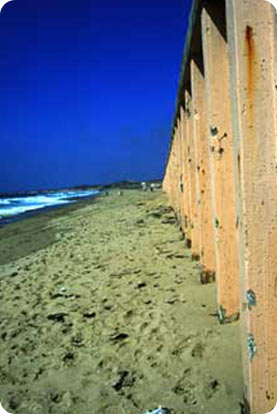When a powerful tsunami slammed into the coast of India in December of 2004, it killed thousands. Yet even though it was directly in the tsunami’s path, the town of Pondicherry was spared -- protected by a seawall that was started by French engineers almost three centuries earlier.
 A seawall in California. Credit: National Oceanic and Atmospheric Administration
A seawall in California. Credit: National Oceanic and Atmospheric AdministrationSeawalls have been protecting coastal settlements for thousands of years. They can prevent flooding during hurricanes, and prevent the beach from eroding into the sea.
Some of the earliest seawalls were built with “cribs” -- wooden boxes that were towed into place, then filled with rocks to anchor them to the ocean floor. Later seawalls were made of slabs or blocks of rock. Beginning in the 19th century, these were often backed by concrete to prevent the waves from eroding the beach behind them during big storms.
When Galveston, Texas, was destroyed by a hurricane in 1900, the town built a seawall that eventually stretched across more than 10 miles. Pine poles up to 50 feet long were driven into the beach. These pilings were topped with concrete. This structure was sculpted to deflect the energy of crashing waves upward. And giant boulders were tossed into the Gulf of Mexico at the foot of the wall to keep the waves from scouring out the sand and rocks below it.
Today, seawalls often are made of steel, and their surfaces are sometimes curved to reflect the wave energy more efficiently. But they all serve the same purpose: protecting land -- and people -- from the ravages of the sea.

